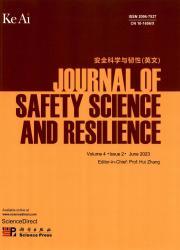Clutaxis: An information-driven source search method balancing exploration and exploitation in turbulent environments
IF 3.4
Q1 PUBLIC, ENVIRONMENTAL & OCCUPATIONAL HEALTH
引用次数: 0
Abstract
Locating unknown emission sources in turbulent environments is a challenging yet crucial task, particularly in emergency response scenarios. Existing studies have developed information-theoretic approaches to fuse intermittent information collected by mobile sensors regarding the sources. This fused information is then used to support source-term estimation (STE) in various search algorithms. Among these, the cognitive strategy—a promising information-driven search algorithm—leverages a reward-based action selection mechanism to balance exploration and exploitation during each search step. However, this mechanism is hampered by a high computational load and rigid search trajectories, limiting its application in real-world systems. To address these issues, this paper proposes a novel information-driven search method called Clutaxis, based on a global exploration and exploitation tradeoff principle. Specifically, a particle filter is leveraged to maintain the STE. After projecting the particle filter samples onto a 2D search scene, the density-based spatial clustering of applications with noise (DBSCAN) algorithm is used to extract the density information of the samples, which is then used to construct a belief source area (BSA). By leveraging the uncertainty of the BSA, Clutaxis adopts explorative or exploitative actions with no restrictions on motion direction. Through dedicated simulations, the experimental results demonstrate the robustness of Clutaxis to key parameters and its advantages in computational complexity and search performance compared to two state-of-the-art algorithms (Infotaxis and Entrotaxis) and two Clutaxis variants (Clutaxis_ER and Clutaxis_EI).
Clutaxis:一种在动荡环境中平衡勘探和开发的信息驱动的资源搜索方法
在动荡环境中定位未知排放源是一项具有挑战性但又至关重要的任务,特别是在应急响应场景中。现有的研究已经发展了信息论方法来融合由移动传感器收集的关于源的间歇性信息。然后使用这些融合的信息来支持各种搜索算法中的源项估计(STE)。其中,认知策略是一种很有前途的信息驱动搜索算法,它利用基于奖励的行为选择机制来平衡每个搜索步骤中的探索和利用。然而,这种机制受到高计算负荷和刚性搜索轨迹的阻碍,限制了其在现实系统中的应用。为了解决这些问题,本文提出了一种基于全局探索和利用权衡原则的信息驱动搜索方法Clutaxis。具体来说,利用粒子过滤器来维持STE。将粒子滤波样本投影到二维搜索场景后,采用基于密度的带噪声应用空间聚类(DBSCAN)算法提取样本的密度信息,并利用该密度信息构建置信源区域(BSA)。通过利用BSA的不确定性,Clutaxis采取不受运动方向限制的探索性或剥削性行为。通过专门的仿真,实验结果证明了Clutaxis对关键参数的鲁棒性,以及与两种最先进的算法(Infotaxis和Entrotaxis)和两种Clutaxis变体(Clutaxis_ER和Clutaxis_EI)相比,其在计算复杂度和搜索性能方面的优势。
本文章由计算机程序翻译,如有差异,请以英文原文为准。
求助全文
约1分钟内获得全文
求助全文
来源期刊

安全科学与韧性(英文)
Management Science and Operations Research, Safety, Risk, Reliability and Quality, Safety Research
CiteScore
8.70
自引率
0.00%
发文量
0
审稿时长
72 days
 求助内容:
求助内容: 应助结果提醒方式:
应助结果提醒方式:


